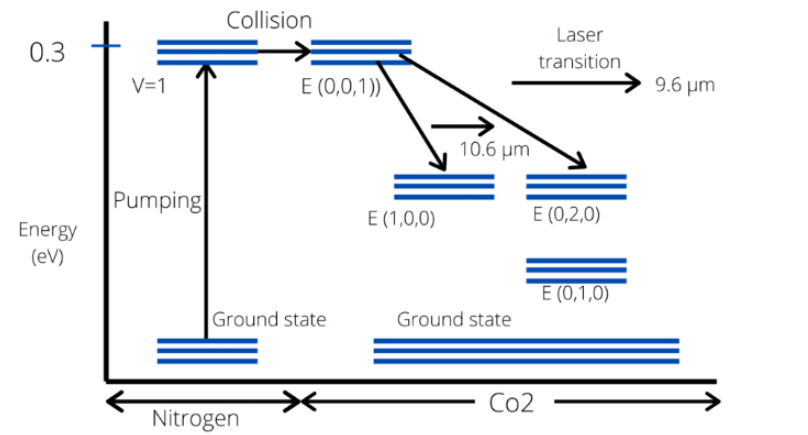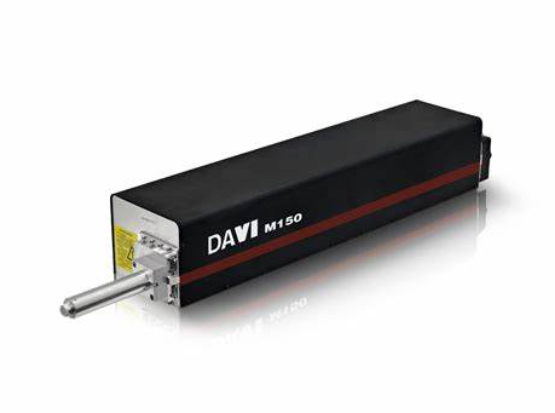제조업의 변혁과 업그레이드라는 중요한 시기에, 장핀 테크놀로지는 이산화탄소 레이저를 전략적 개발 방향으로 선택했습니다. 이는 뛰어난 시장 규모와 성장률뿐만 아니라, 정밀성, 유연성, 친환경성을 지향하는 미래 제조업의 핵심 트렌드와도 부합하기 때문입니다. 특히 중국이 "제조업 강국"에서 "제조업 강국"으로 도약하는 과정에서, 고정밀 첨단 레이저 가공 장비의 독자적인 관리는 산업 사슬의 안전을 보장하는 핵심 고리가 되었습니다. 이제 이산화탄소 레이저에 대해 함께 살펴보겠습니다.
작동 원리:
이산화탄소 분자는 고에너지 수준으로 직접적으로 흥분될 수 있지만, 많은 연구들은 질소 분자의 공명 에너지 전달이 가장 효과적임을 입증했다. 질소 분자는 방전에 의해 메타안정 진동 에너지 수준으로 흥분되며, 이는 이들이 이산화탄소 분자와 충돌할 때 흥분된 에너지를 이산화탄소 분자로 전달하게 된다. 그 후, 흥분된 이산화탄소 분자는 주로 레이저 전이에 참여한다. 헬륨은 레이저에서 저에너지 입자의 수를 줄이고 열도 제거하는 역할을 한다. 다른 성분들, 예를 들어 수소나 수증기 등은 방전 중 생성된 일산화탄소(CO)를 재산화시켜 이산화탄소로 변환하는 데 도움을 준다.

CO2 레이저는 일반적으로 10.6 μm의 파장을 방출할 수 있지만, 9-11 μm 영역(특히 9.6 μm)에는 몇십 개의 다른 레이저 스펙트럼 선이 존재합니다. 이는 이산화탄소 분자의 두 가지 서로 다른 진동 모드가 저에너지 수준으로 사용될 수 있으며, 각 진동 모드는 많은 회전력에 해당하여 여러 하위 에너지 수준을 생성하기 때문입니다. 대부분의 상업용 CO2 레이저는 10.6 μm의 표준 파장을 방출하지만, 특정 파장(예: 10.25 μm 또는 9.3 μm)에 대해 최적화된 일부 장치도 있으며, 이러한 장치들은 특정 재료(예: 폴리머)를 조사할 때 더 쉽게 흡수되기 때문에 레이저 물질 가공과 같은 특정 응용 분야에 더 적합합니다. 이러한 레이저를 제조하고 조명 용도로 사용할 때는 표준 10.6 μm 전달 광학 부품이 과도한 반사를 일으킬 수 있기 때문에 특수 광학 부품이 필요할 수 있습니다.
출력 전력과 효율:
대부분의 경우 평균 출력 전력은 수십 와트에서 수킬로와트까지 varies합니다. 전력 변환 효율은 약 10%-20%로 대부분의 가스 레이저 및 램프 펌핑 고체 상태 레이저보다 높지만, 많은 다이오드 펌핑 레이저보다는 낮습니다. 높은 출력 전력과 긴 방출 파장 때문에 CO2 레이저는 보통 산화아연(ZnSe) 또는 황화아연(ZnS)과 같은 재료로 만들어지는 고품질 적외선 광학 부품이 필요합니다. CO2 레이저는 높은 출력 전력과 높은 구동 전압을 가지고 있어 심각한 레이저 안전 문제를 초래합니다. 그러나 긴 작업 파장 덕분에 저 강도에서는 상대적으로 인체에 안전합니다.
CO2 레이저 유형:
레이저 파워가 몇 와트에서 수백 와트까지 변할 때, 일반적으로 밀폐형 튜브 또는 유량이 없는 레이저가 사용되며, 레이저 공진기와 가스 공급부는 모두 밀폐된 튜브 내에 위치합니다. 폐기열은 주로 헬륨의 영향으로 확산을 통해 또는 천천히 흐르는 가스를 통해 파이프 벽으로 전달됩니다. 이 종류의 레이저는 구조가 콤팩트하고 견고하며 내구성이 뛰어나 작업 수명이 수천 시간 이상에 이를 수 있습니다. 이 시점에서 연속적인 가스 재생 방법이 채택되어야 하며, 특히 일산화탄소의 재산화를 촉진하여 이산화탄소의 분해를 방지하기 위해 촉매를 사용해야 합니다. 광선 품질은 매우 높을 수 있습니다. 고출력 확산 냉각 슬래브 레이저는 일련의 평면 수ooled RF 전극 사이의 간격에 가스를 배치합니다. 전극 간격이 전극 너비보다 작으면 과도한 열은 효과적으로 확산을 통해 전극으로 전달됩니다. 에너지를 효율적으로 추출하기 위해 비정상 공진기를 일반적으로 사용하며, 고반사측에서 출력 결합이 이루어집니다. 적절한 광선 품질하에서 수킬로와트의 출력 전력이 달성될 수 있습니다. 빠른 축방향 유동 레이저와 빠른 교차 유동 레이저도 수킬로와트의 연속파 출력 전력을 위해 적합하며 높은 광선 품질을 제공합니다. 과잉 열은 빠르게 흐르는 혼합 가스에 의해 제거되며, 외부 냉각기(열교환기)를 통과한 후 다시 방전에 사용됩니다. 혼합 가스는 지속적으로 재생되고 필요시 교체될 수 있습니다. 교차 유동 레이저는 최고 출력 전력을 달성할 수 있지만, 일반적으로 광선 품질은 낮습니다.
측면으로 excitation된 대기 레이저의 압력은 매우 높습니다 (약 1 대기압). 종방향 방전에 필요한 전압이 너무 높아서 관 내부에서 일련의 전극을 사용하여 횡방향 excitation을 수행해야 합니다. 이 레이저는 가스 방전이 고전압에서 불안정하기 때문에 펄스 모드로만 작동합니다. 그들의 평균 출력 파워는 일반적으로 100와트 미만이지만, 고펄스 반복 주파수와 결합하면 수십킬로와트까지 도달할 수 있습니다.
고체 레이저는 희토류 또는 전이 금속 이온으로 도핑된 결정이나 유리와 같은 고체 증폭 매체를 기반으로 하는 레이저로, 출력 파워가 몇 밀리와트에서 몇 킬로와트까지 생성될 수 있습니다. 많은 고체 레이저는 광 펌핑에 플래시 램프나 아크 램프를 사용합니다. 이러한 펌핑 소스는 비교적 저렴하고 매우 높은 파워를 제공할 수 있지만, 효율성이 다소 낮고 수명이 평균이며, 열 렌즈 효과와 같은 이득 매체에서 강한 열적 영향이 발생합니다. 레이저 다이오드는 일반적으로 고체 레이저를 펌핑하는 데 사용되며, 이러한 레이저 펌핑 고체 레이저(DPSS 레이저, 또는 전고체 레이저라고도 함)는 설치가 컴팩트하고 수명이 길며 빔 품질이 우수하다는 등 많은 장점이 있습니다. 그 작동 모드는 연속파일 수 있으며, 즉 연속적인 레이저 출력을 생성할 수 있고, 또는 펄스 형식일 수 있으며, 즉 짧은 시간 동안 고출력 레이저 펄스를 생성할 수 있습니다.
이산화탄소 레이저는 독특한 파장 이점과 광범위한 재료 적응성으로 인해 전 세계 산업 가공, 의료 미용, 및 신에너지 분야에서 대체할 수 없는 전략적 가치를 보여주고 있습니다. 금속 가공 분야에서 섬유 레이저의 경쟁 압력에도 불구하고, 이산화탄소 레이저 기술은 비금속 가공, 고정밀 도장 제거, 심층 피부 치료와 같은 특수 분야에서 여전히 핵심 경쟁 우위와 넓은 혁신 공간을 가지고 있습니다.
장빈 테크놀로지에게는 중국 제조업의 업그레이드와 세계 에너지 전환으로 인한 역사적 기회를 포착해야 하며, 주요 세 방향에 초점을 맞추어야 한다: 고출력 안정성 돌파(예: '온도 멸광' 효과 해결), 특수 시나리오 개발(신에너지 장비 처리), 중소기업을 위한 맞춤형 솔루션 제공이다. '산업-대학-연구-응용' 협동 혁신 체계를 구축하고 지역 산업 클러스터 생태계에 통합함으로써, 장빈 테크놀로지는 이산화탄소 레이저의 기술 혁명과 시장 재구성의 중요한 시기에 기술 추종자에서 혁신 리더로의 전략적 전환을 이루게 될 것이다.

 EN
EN
 AR
AR
 BG
BG
 CS
CS
 DA
DA
 NL
NL
 FI
FI
 FR
FR
 DE
DE
 EL
EL
 IT
IT
 JA
JA
 KO
KO
 NO
NO
 PL
PL
 PT
PT
 RO
RO
 RU
RU
 ES
ES
 SV
SV
 TL
TL
 ID
ID
 LV
LV
 SR
SR
 SK
SK
 SL
SL
 UK
UK
 VI
VI
 SQ
SQ
 ET
ET
 HU
HU
 TH
TH
 TR
TR
 FA
FA
 GA
GA
 BE
BE
 AZ
AZ
 KA
KA
 LA
LA
 UZ
UZ

